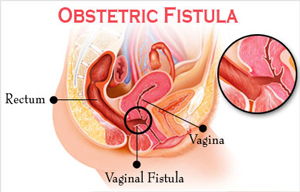OBSTETRIC FISTULA (Part One)
Overview

Obstetric fistula is an abnormal communication with the vagina, rectum, or urinary bladder, which develops after a difficult and prolonged birth leading to urinary and fecal incontinence.
- Vesicovaginal fistulas are a communication between the vagina and the urinary bladder.
- Rectovaginal fistulas are a communication between the vagina and the rectum.
Obstetric fistula is an indicator of the health system's failure to provide proper, timely, and acceptable intrapartum service.
Considered a condition of neglect, it is more common in developing countries, underestimated as a cause of maternal mortality and morbidity, and is preventable and treatable.
Prevention can be achieved through proper nutrition, evaluating the pregnant woman's body length to assess the mode of delivery, difficult childbirth, and cesarean section in the case of cephalopelvic disproportion.
In developing countries, the main cause is childbirth, while in developed countries, the primary cause is iatrogenic (radiation, surgery, chemotherapy).
Incidence / Prevalence
For every maternal death, 20-30 women develop serious obstetric complications including obstetric fistula.
4 out of 5 iatrogenic obstetric fistulas are complications of surgery (cesarean section, hysterectomy, ruptured uterus).
1-8% of fistulas are rectovaginal while the rest are vesicovaginal.
Fistulas are formed 90.4% by childbirth, 5.3% by pelvic operations, and 4.3% by sexual intercourse.
3 in every 100 women have symptoms of fistula during their lifetime, and of these, 1 in 1000 women have true symptoms of it.
The incidence is 1-2 per 1000 births or 50,000-100,000 new cases every year.
Various studies show that we have a low prevalence from an incomplete study of the problem and from incomplete reporting as a result of treating many cases outside of the hospital.
There is no accurate method of measuring prevalence. Mixed methods, surveillance, interviews, and case reporting from the health system are used.
Risk Factors
- Social, economic, and cultural factors
- Difficulties in accessing healthcare
- Improper healthcare service
- Difficult childbirth
- Short stature
- Contracted uterus
- Unsafe abortion
- Home childbirth
- Protracted labor (2.5-4 days)
- Sexual abuse
- Childbirth at a young age (adolescent)
- Poverty
- Malnutrition
- Lack of education
There are also some dangerous procedures that are conducted in different places. GISHIRI, a procedure carried out in Nigeria, where the labia are cut with a sharp object. In Arabia, a caustic substance is inserted into the vagina as a cure for gynecological conditions or to help the vagina return to its normal state after childbirth so as to ensure sexual pleasure for the partner. The fistula will be created by the fibrosis that causes obstruction of the birth canals, and in subsequent childbirth, conditions suitable for injuries are created, or from the chemical damage caused by the caustic substance used.
Pathogenesis
Forced labor leads to ischemic necrosis in the soft tissues between the vagina and the urinary bladder or rectum. This happens when the fetal head stays in the pelvis and exerts prolonged pressure on the anterior vaginal wall and consequently presses on the neck of the urinary bladder and urethra.
It can be caused by direct injury in precipitous labor.
It is favored by episiotomy and by childbirth with instruments (forceps or vacuum).
Injuries
- Urinary injuries. Injuries include the urinary bladder, ureters, and kidney (hydronephrosis, ascending infections).
- Genital injuries. Injuries include the vagina, cervix, and uterus.
- Neurological injuries. Injuries are caused by compression in the lumbosacral plexus. A neurogenic urinary bladder is caused as a result of damage to the bladder nerves.
- Musculoskeletal injuries. Includes injuries to the perineal support and avulsion of the levator ani muscles.